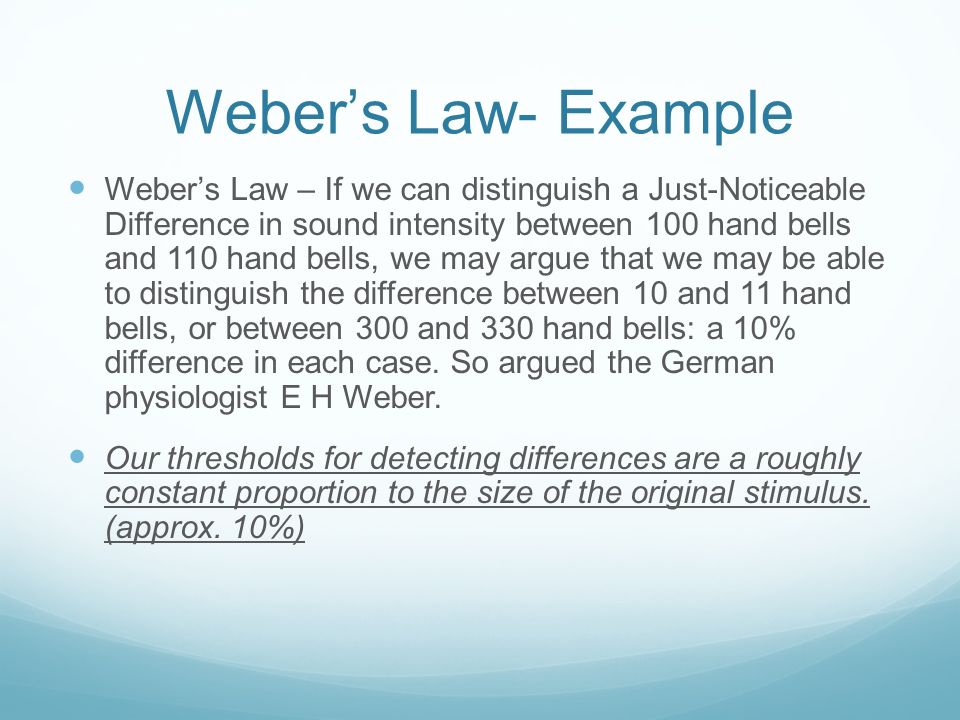Describe Weber's Law Using an Example
Lets look at some examples where Webers law is both present and useful. Webers Law states that the size of the difference threshold is proportional to the intensity of the standard stimulus.

Sensation And Perception Ppt Video Online Download
Cold Spring Harbor Symposia on Quantitative Biology 30.

. Law law of nature a generalization that describes recurring facts or events in nature. The ratio of II for both instances 0220 0550 01 is the same. The law postulating that the strength and intensity required to identify modifications within a stimulant is correlated to the absolute magnitude of the stimulant.
Webers law also called WeberFechner law is a historically important psychological law quantifying the perception of change in a given stimulus. 1965 Optic nerve impulses and Webers Law. The WeberFechner laws are two related hypotheses in the field of psychophysics known as Webers law and Fechners law.
An approximately accurate generalization in psychology. 1957 Change of organization in the receptive fields of the cats retina during dark adaptation. The law states that the change in a stimulus that will be just noticeable is a constant ratio of the original stimulus.
Webers law is often used in marketing particularly with regards to price increases for products and services. The size of the difference threshold a constant ratio of the standard stimulus is referred to as the Webers fraction. The concept is that one will not notice the difference in stimuli when there is a minimal change in the physical characteristic.
It requires an effort to hold 30kgs. This includes stimuli to all senses. About Press Copyright Contact us Creators Advertise Developers Terms Privacy Policy Safety How YouTube works Test new features Press Copyright Contact us Creators.
This pricing guideline is in keeping with Webers Law. Webers Law states that the ratio of the increment threshold to the background intensity is a. Webers law also called Weber-Fechner law historically important psychological law quantifying the perception of change in a given stimulus.
Webers original 1834 observation was that if you are. It implies for example that it is possible to increase prices by small enough amounts that fall under the absolute threshold without your customers even noticing. Both laws relate to human perception more specifically the relation between the actual change in a physical stimulus and the perceived change.
CrossRef Google Scholar PubMed. For the weight of magnitude I of 20 kg the increment threshold for detecting a difference was a I pronounces delta I of 02 kg. The higher the original price the eater is the needed price reduction.
Thinking Intelligence And Language 8 Development Across The Life Span 9 Motivation And Emotion 10 Sexuality. Webers Law can provide valuable guidance. Then the minimal weight in between 30kg to 31kg weight is added for say 005 kg we may not observe much difference.
According to Webers law this difference threshold is a constant proportion of the original threshold size. And let us assume that you have lifted and a whole day weight of 30kg. Suppose that you presented two spots of light each with an intensity of 100 units to an observer.
It has been shown not to hold for extremes of stimulation. This is Webers Law. Retailers have long made use of the general rule of thumb that markdowns must amount to at least 20 percent of the old price.
One example is weight loss to two different people. The task is to tell apart or discriminate two things that differ by only a slight amount. Weber states that the minimum.
We bers law ˈweb-ərz- ˈvā-bərz- Medical Definition of Webers law. The law states that the change in a stimulus that will be just noticeable barely perceivable. 1 n psychophysics the concept that a just-noticeable difference in a stimulus is proportional to the magnitude of the original stimulus Webers law explains why you dont notice your headlights are on in the daytime Type of.
The smallest change in the intensity of a stimulus capable of being perceived is proportional to the intensity of the original stimulus. Webers Law expresses a general relationship between an initial stimulus a quantity or intensity and the increased stimulus required for a change in the stimulus to be detected. Webers law also called WeberFechner law is a historically important psychological law quantifying the perception of change in a given stimulus.
For the weight of magnitude I 50 kg the increment threshold I 05 kg. Webers Law also known as Weber-Fechner Law is a law that helps us understand or quantify rather the perception of changes in a given stimulus. September 2 2021 The just noticeable difference also known as the difference threshold is the smallest possible difference between two stimuli that can be detected at least half the time.
Webers Law more simply stated says that the size of the just noticeable difference ie delta I is a constant proportion of the original stimulus value. One example is weight loss to two different people. But it keeps on increasin.
The Weber and Fechner law can be explained by using a simple experiment. Vision hearing taste touch and smell. The concept is that one will not notice the difference in stimuli when there is a minimal change in the physical characteristic.
1 The Science Of Psychology 2 The Biological Perspective 3 Sensation And Perception 4 Consciousness 5 Learning 6 Memory 7 Cognition. It is a constant ratio. The ratio of the magnitude of a stimulant to the quantity which importance must be altered in effort for the modification to be interpreted is a constant.
Each noticeable stimulus increment is a constant. July 9 2016 by Kendra Cherry. Weight The original proposal for this theory in 1834 was made on the basis of psychophysics or the intersection between psychology and physics.


No comments for "Describe Weber's Law Using an Example"
Post a Comment